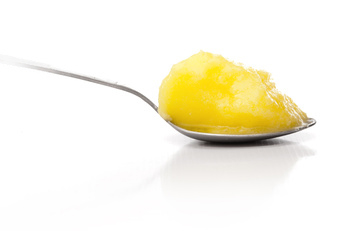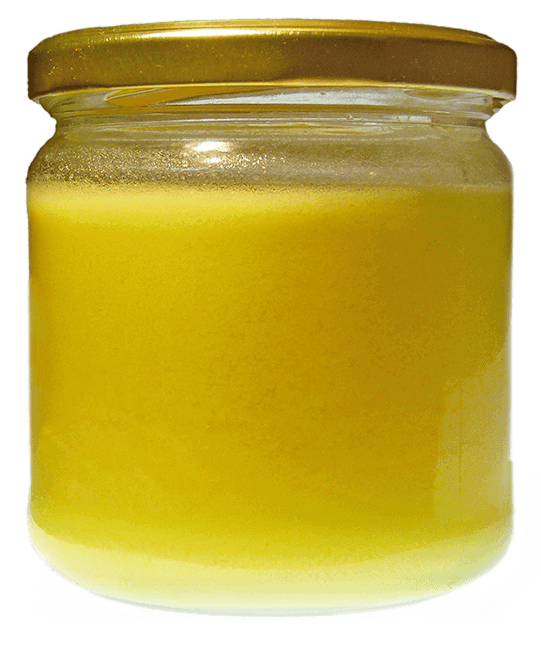Ayurveda knows Ghee – clarified butter – both as a remedy and a food. Ayurveda utilizes the beneficial qualities of Ghee in internal as well as external treatments. Ghee is an indispensable part of this oldest art of healing and, along with milk and honey, is considered a natural Rasayana, i.e. an Ayurvedic preparation for prevention, strengthening and rejuvenation.
Ghee is called the elixir of life because it has a cell-regenerating and rejuvenating effect. A Japanese study found that Ghee neutralizes free oxygen radicals – oxygen molecules with unpaired electrons that damage cells and cause aging – 500 times more effectively than vitamins A, E, and C. In addition, Ghee promotes the formation of Ojas, the subtlest end product of digestion, in the body’s cells. Thereby it ensures a healthy metabolism and a strong immune system.

Ghee is also an excellent Anupanam: it’s an ideal means of transport for the healing ingredients of herbs and minerals, which it binds to itself and carries into all the cells.
Further, Ghee helps with detoxification, because it binds fat-soluble environmental and metabolic toxins, which can then be excreted via the body’s own transport routes. This is why Ghee is so important for the Ayurvedic Panchakarma course of treatment: one research study measured that up to 58% of the environmental toxins present in the blood were eliminated after just twelve days of treatment.
Ghee as a remedy
The healing effects of Ghee as we experience and utilize them today are also described in the classic Ayurveda texts:
- Ghee has an anti-inflammatory effect;
- cools excessive heat;
- detoxifies;
- rejuvenates the skin;
- cleans the blood;
- strengthens eyesight;
- strengthens and regenerates the digestive function *;
- strengthens the immune system;
- harmonizes hormonal balance;
- improves sleep;
- improves memory.
Today we also know that Ghee:
- is a natural scavenger of free radicals;
- contains 4–5% linoleic acid and thus promotes the growth and health of the cells;
- contains vitamins A, D, E, K, B3 and the minerals sodium, potassium, calcium, phosphorus, magnesium and iron.
*The amount of Ghee taken should be adjusted individually, since a small amount fuels the digestive fire, but too much Ghee smothers it. If in doubt, best ask an Ayurvedic physician.
Ghee as a food
Ayurveda recommends taking Ghee regularly. Our body needs fat to break down and utilize vitamins and nutrients from the food and to produce hormones from them. Our cells, skin and hair also need healthy fats to build and grow. Therefore it’s worth making Ghee an integral part of our menu.
- Ghee is easy to digest;
- makes dishes more digestible and intensifies their taste;
- preserves the vitamins in the food during cooking;
- can be heated to high temperatures – the fatty acids in the Ghee remain stable up to 190 ºC;
- is durable and easy to store;
- has an absorption rate of 95%, the highest of all fats and oils.
Organic Ghee is available in health food stores. Here’s how you can easily make it yourself: Making Ghee
Download this article as a PDF file


Thank you so very much for your great service to humanity.
Ann Kalyan
Dear Ann, thank you very much for your nice answer, it’s a joy for us!
Dear Reader,
Here’s an additional tip for preparing Ghee.
Janet Smith from Vermont, USA told us that a chemist at Maharishi International University, passed on an easy method of making Ghee confidently, indicating exact temperatures:
Set the alarm of a probe thermometer to 110 °C. As long as the Ghee contains some water, it will simmer at 100 °C. As soon as all the water has evaporated, the temperature will rise. When it reaches 110 °C, the thermometer will alert you to switch off the hob.
Wait until the temperature of the Ghee is 114–119 °C, then remove it from the heat. That is the exact temperature at which all the water has evaporated and the milk solids have separated and solidified.
My question is stirring or no stirring ghee during the cooking.
it is better to not stir since this will stir up the residues from the bottom of the pot, ghee will be perfect without stirring, jut let the water evaporate and the proteins clog at the surface and the bottom of the pot., that is enough…